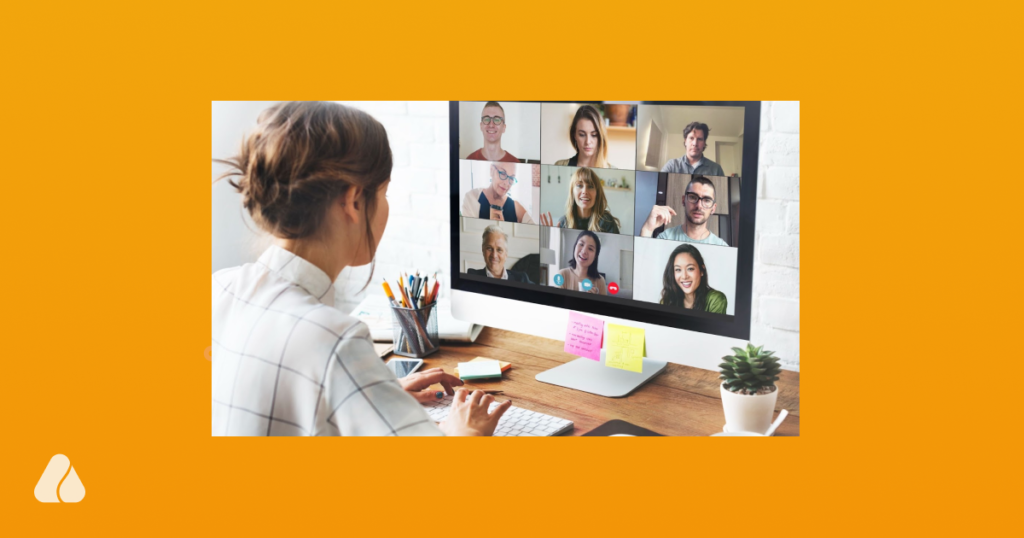The truth is, coordinating webinar events can be surprisingly challenging. From missing out on critical details, overlooking important points, or unexpected errors, there are plenty of pitfalls that can significantly impact the overall strategy and outcomes, affecting the entire webinar process.
Whether you are hosting an internal skill-development session for your employees or a product demo webinar for prospects, coordinating any kind of webinar requires attention to detail at every step. It’s important to have an understanding of what all goes into the whole process from beginning to end for coordinating webinar events successfully.
In this blog, we aim to present you with 40+ effective tips that will help you not only coordinate webinar events effectively but also provide you with an adequate understanding of the entire webinar hosting process.
40+ Simple & Effective Tips for Coordinating Webinar Events Successfully
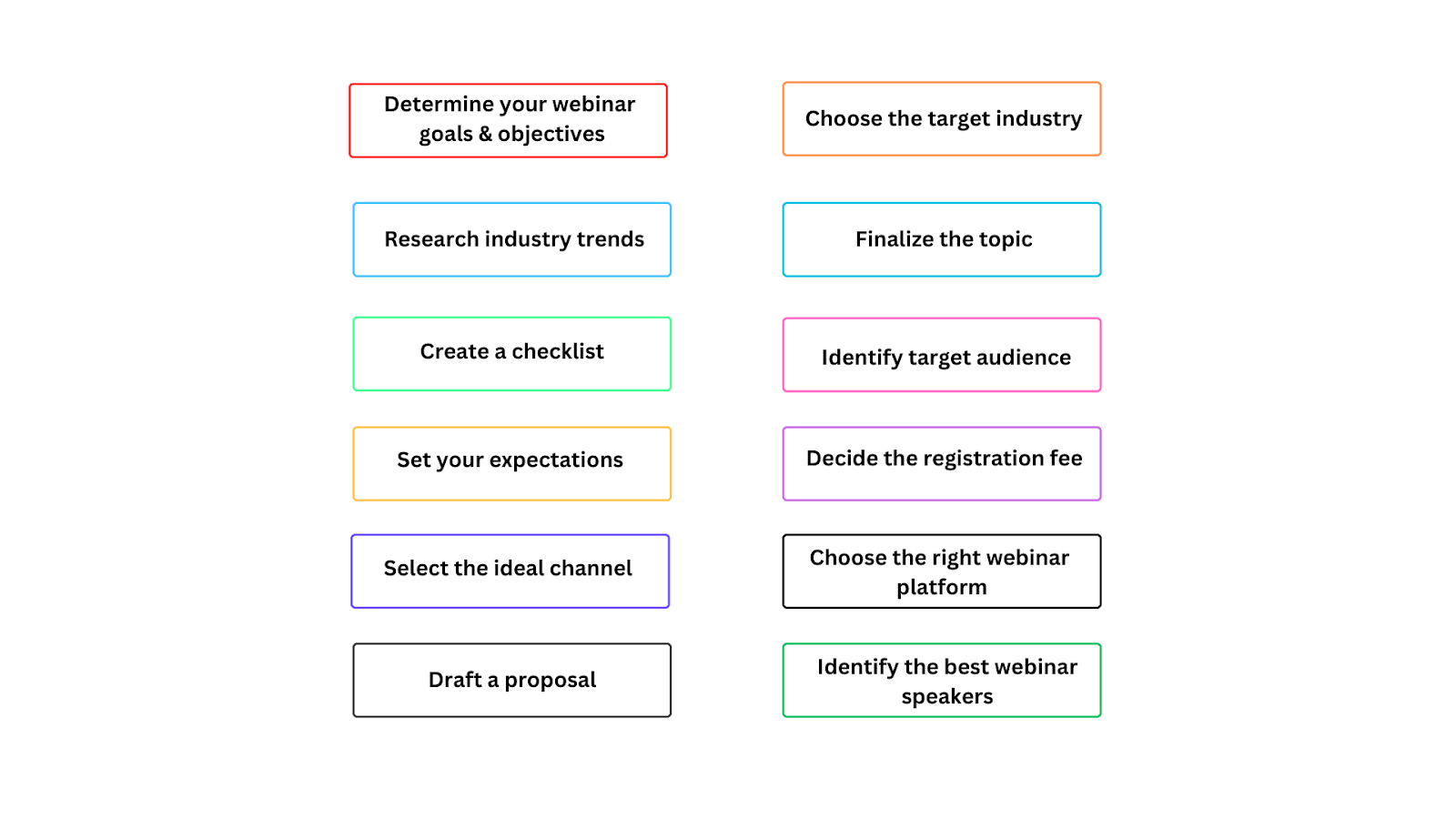
1. Determine your webinar goals & objectives
Define and decide the purpose of your webinar. It can be education, lead generation, employee engagement, new product launch, or product demo. To build a well-structured strategy, it’s crucial to have a clear understanding of your webinar’s goals and objectives.
2. Choose the target industry
Identify the specific industry or sector your webinar will cater to. This decision will influence your content, marketing approach, and potential partnerships. Focusing on a particular industry will allow you to create more tailored and relevant content.
3. Research industry trends
Stay up-to-date with the latest trends and developments within your chosen industry. This research will help you create and position your webinar as a valuable resource. Having an understanding of the new industry trends will help you identify potential hot topics that will attract your audience, as well as give you an upper hand among your competitors.
4. Finalize the topic
Based on your objective, target industry, and trend research, select a specific topic for your webinar. Ensure the topic is both interesting and relevant to your audience and aligns with your business goals. Choosing the right topic will significantly boost your webinar registration and engagement rates.
5. Create a checklist
Create a comprehensive checklist of all the tasks required for the webinar. This list should cover everything from planning and promotion to execution and follow-up. A thorough checklist helps ensure no crucial steps are overlooked and keeps the planning process organized.
6. Identify target audience
Identify the specific demographic, region, or designation you aim to reach with your webinar. Having an accurate understanding of your audience helps you tailor your content, marketing messages, and engagement strategies.
7. Set your expectations
Based on your webinar goals, set the right expectations for the webinar. These might include the number of registrants you are aiming for, total leads generated, or conversion rates. Create a well-structured webinar toolkit and include budget templates, registration projections, a growth plan, team responsibilities, etc., to outline your requirements & expectations.
Setting expectations beforehand and having a proper plan gives you a clear picture of tasks & responsibilities, which helps with effective resource allocation, and in evaluating the success of your webinar.
8. Decide the registration fee
Determine whether your webinar will be free or paid, and if paid, calculate and set an appropriate fee. Consider factors like your target audience, the value of your content, the popularity of your webinar speakers, and your overall webinar objectives. The registration fee can impact attendance numbers and the perceived value of your event.
9. Select the ideal channel
Select an appropriate channel to host your webinar , one that will help you maximize audience’s reach and accessibility. It can be via a webinar platform, social media channels, or live streaming platforms.
10. Choose the right webinar platform
If you’ve opted to host your webinar on a webinar platform, start looking for the one that meets your allocated budget, is suitable for your audience size, and has features like engagement capabilities, integration support, branding & customization, session recording, and more.
The right webinar platform enables you to streamline your webinar journey, and help you enhance the user experience for presenters as well as attendees.
11. Draft a proposal
Create a detailed and visually appealing proposal, outlining the webinar’s concept, objectives, target audience, and potential benefits. You can use this document for various purposes, such as to secure internal approvals, attract sponsors, or recruit speakers.
12. Identify the best webinar speakers
Identify and reach out to potential speakers who are experts in your chosen topic. Use the webinar proposal, customize it based on the speaker profile, write a bio, add images, and include the benefits they will receive from this partnership.
The popularity and following of speakers will improve your brand visibility, enhance your webinar’s credibility, and help you gain more registrations.
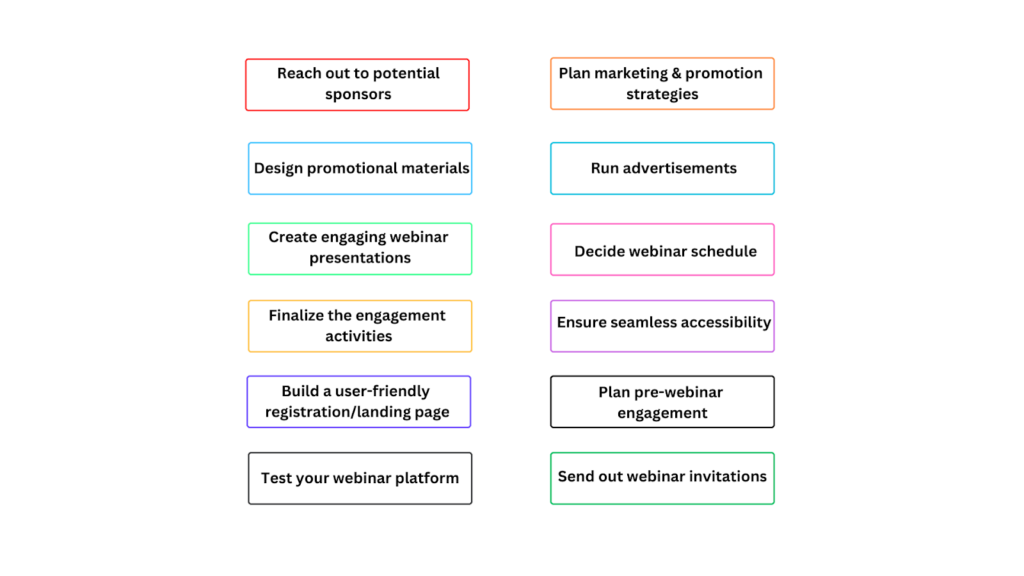
13. Reach out to potential sponsors
Depending on the topic, format, budget, and size of your webinar, seek out companies or organizations that might be interested in sponsoring it, if needed. Sponsorships are helpful for large-scale, high-expense, and paid webinars as they provide financial support, expand your reach, and add credibility to your webinar event.
14. Plan marketing & promotion strategies
Develop a creative marketing plan to promote your webinar. Your plan should be drafted and dedicated to include a mix of channels such as email marketing, social media marketing, content marketing, and potentially, paid advertising (if needed) to expand your reach. A well-executed promotion strategy is crucial for attracting the right audience and achieving your registration goals.
15. Design promotional materials
Create visually appealing, impactful, and informative marketing materials aligned with your topic and offerings to promote your webinar. This may include banners, pamphlets, videos, email templates, social media graphics, blog posts, and landing page content. These promotional materials help you spread the word, engage your audience, and create anticipation for your webinar.
16. Run advertisements
If your budget allows it, consider running targeted ads to reach a wider audience. This could include social media ads, Google Ads, or industry-specific advertising platforms. These targeted ads can help you significantly boost your registration numbers and reach audiences beyond your existing network.
17. Create engaging webinar presentations
Develop engaging, visually-appealing slides or other presentation materials for your webinar. Ensure your content is clear, concise, and covers all the key aspects of your webinar topic. Incorporating pictographs, videos, graphics, gifs, and high-quality presentation materials can greatly enhance the audience’s learning experience, engagement, and involvement with the content.
18. Decide webinar schedule
Plan the timing and flow of your webinar, including speaker segments, panel discussions, Q&A sessions, engagement activities, and breaks, if applicable. A well-structured schedule ensures all key points are covered and successfully conveyed to the attendees. Consider your audience’s time-zone preferences before deciding the time, duration, and webinar schedule.
19. Finalize the engagement activities
Plan interactive elements such as polls, Q&A, speed networking sessions, or breakout rooms to keep your audience engaged. These activities can enhance learning, boost engagement, and make the webinar more memorable for your attendees.
Engagement activities also provide opportunities for attendees to interact with speakers and network with each other, improving two-way communication during webinars.
20. Ensure seamless accessibility
Make sure your webinar platform is easily accessible to all – speakers and registered attendees. Provide clear instructions on how to join the webinar, including supported browsers & versions, required bandwidth, and offering multiple device options, like laptops, mobile phones, or tablets, if possible.
21. Build a user-friendly registration/landing page
Create a user-friendly landing page for your webinar with all relevant information and a clear call-to-action for registration. This page should highlight the value proposition of your webinar and simplify the registration process.
A simple, well-designed registration/landing page will help you reduce the number of abandoned forms and significantly improve conversion rates.
Note: For paid webinars, ensure that your registration form is seamlessly integrated with secure payment gateways and easily accessible to attendees.
22. Plan pre-webinar engagement
Develop strategies to engage registrants before the webinar. This could include sending reminder emails, sharing preparatory materials, or creating a social media buzz via polls, countdowns, or contests. These pre-webinar engagement activities can increase attendance rates and encourage participants to actively participate.
23. Test your webinar platform
Thoroughly test all aspects of your chosen webinar platform well in advance. This includes audio-visual quality and functionality, screen layout, interactive features, recording capabilities, live transcriptions, API integration, and other technical aspects.
Testing your webinar platform not only helps prevent technical issues during the live event, but also offers you an opportunity to familiarize yourself with the platform and all its features.
24. Send out webinar invitations
You can create personalized templates in message/email formats, as required and send invitations to your target audience through various channels, including via emails, social media, or community forums.
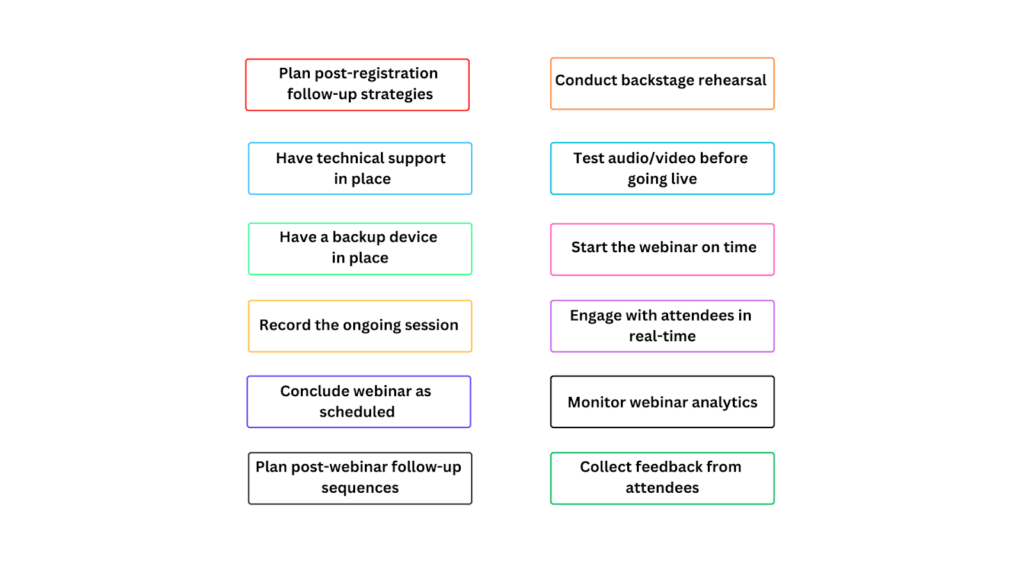
25. Plan post-registration follow-up strategies
Developing a series of communications post-registration will keep your registrants engaged and remind them of the upcoming webinar. This might include confirmation emails, calendar invites, and reminder messages. These post-registration follow-ups help significantly improve overall webinar turnout and attendance rates.
26. Conduct backstage rehearsal
Schedule an end-to-end backstage rehearsal with the host, co-host, speakers, and technical staff a day before the webinar, and if possible, another quick one before going live with the webinar. This helps identify and tackle any potential issues with content flow, timing, or the webinar platform.
27. Have technical support in place
Ensure you have dedicated technical support staff available before and during the webinar. This helps to quickly address any issues that the presenters or attendees are facing. Having reliable and active technical support is crucial for maintaining a smooth and professional webinar experience.
28. Test audio/video before going live
Perform a final check of all audio and video equipment 15-30 minutes before the webinar starts. This includes microphones, cameras, and any visual aids you plan to use.
Last-minute testing can help you resolve any issues that may have developed since your last rehearsal, and will offer you an opportunity to make changes to your network or device to improve the audio/video quality.
29. Have a backup device in place
Make sure to include a backup device in case of technical failures. Conduct all the tests and keep your plan-b device ready. This can save your webinar in the event of unexpected issues.
30. Start the webinar on time
Begin your webinar at the scheduled time to respect attendees’ and speakers’ time and to maintain a professional image. If possible, open the virtual room early to allow attendees to join and settle in. Starting on time sets a positive tone for the entire webinar event.
31. Record the ongoing session
Utilize your webinar platform or any third-party platform to capture a recording of your webinar. This recording can be used for post-event marketing, shared with those registrants who couldn’t attend the live session, or repurposed into other content formats. Ensure that you inform participants that the session is being recorded.
32. Engage with attendees in real-time
Actively interact with your audience throughout the webinar via interactive elements like polls, Q&A, and chat messages. This could involve answering questions, acknowledging comments, or facilitating discussions. Real-time engagement keeps attendees involved, connected with the content, and also provides them with valuable insights.
33. Conclude webinar as scheduled
End your webinar as per the schedule. Provide a clear conclusion, summarize key points, and inform participants about any follow-up actions or resources. Your creative closing statement and actions can leave a positive final impression on the webinar attendees.
34. Monitor webinar analytics
Keep track of key metrics during the webinar, such as attendance numbers, engagement levels, and question frequency. Webinar platforms often offer real-time and detailed analytics that can help you adjust engagement strategies, improve the overall experience, and make data-driven decisions for future webinars.
35. Plan post-webinar follow-up sequences
Draft a series of follow-up emails to be sent after the webinar, including thank-you emails, surveys, additional resources, and invitations to future events. Effective follow-up helps maintain the connection and can turn attendees into potential leads or customers.
36. Collect feedback from attendees
At the end of the webinar or in follow-up emails, share a survey form to gather attendee feedback on various aspects of the webinar. This feedback is valuable for improving future webinar strategies and understanding your audience’s needs in detail.
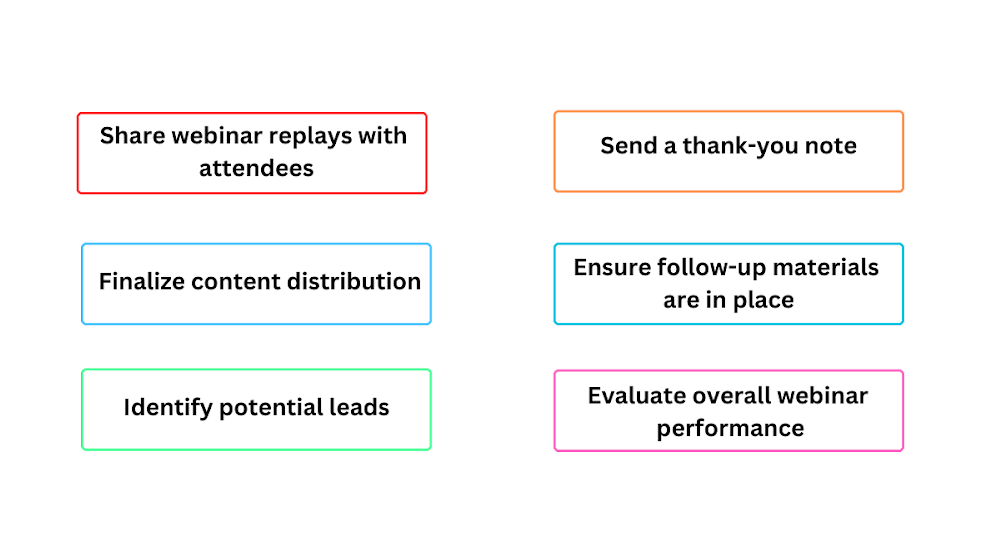
37. Share webinar replays with attendees
Share recordings of the webinar with all registrants, including those who couldn’t attend the live session. You can share your webinar recordings in various formats, such as instant replays, short videos as highlights, and on-demand sessions. This not only allows registrants to review the content at their convenience, but also enables you to repurpose the webinar content and extend its life.
38. Send a thank-you note
Send a personalized thank-you note and express gratitude to attendees, speakers, and sponsors for their contributions and active participation in the event. A personalized thank-you note can help build stronger relationships and leave a positive, lasting impression.
Pro Tip: Create personalized thank-you messages and send them to your team members, as well as co-organizers for their role and contribution to the webinar’s success. This recognition boosts your team’s morale and encourages them to continue contributing actively.
39. Finalize content distribution
Finalize how and where you’ll share the webinar content. This can be:
- Sharing it on social media as posts or snippets
- Creating on-demand videos for your website
- Uploading it as a downloadable resource, and more.
Deciding the content distribution categories helps you repurpose the content, strategize further steps, and take post-webinar actions.
40. Ensure follow-up materials are in place
Prepare any promised resources or materials for distribution to attendees. This could include presentation slides, additional reading materials, or exclusive offers. Prompt delivery of these materials demonstrates reliability, adds value for attendees, and increases the chances of conversions.
41. Identify potential leads
Analyze attendee behavior, engagement metrics, and personal data & interests to identify promising and high-quality leads from the pool of attendees. This analysis helps you prioritize and customize your follow-up efforts and streamline lead generation efforts.
42. Evaluate overall webinar performance
Conduct a detailed review of your webinar’s performance against your initial objectives. Analyze all available data, including attendance rates, engagement metrics, feedback, and lead generation results. This evaluation provides valuable insights on ROI (return on investment) and overall webinar’s success rate.
Why Choose Airmeet for Coordinating Webinar Events
Airmeet is a comprehensive webinar platform and virtual events solution designed to fulfill every event organizer’s specific requirements and needs.
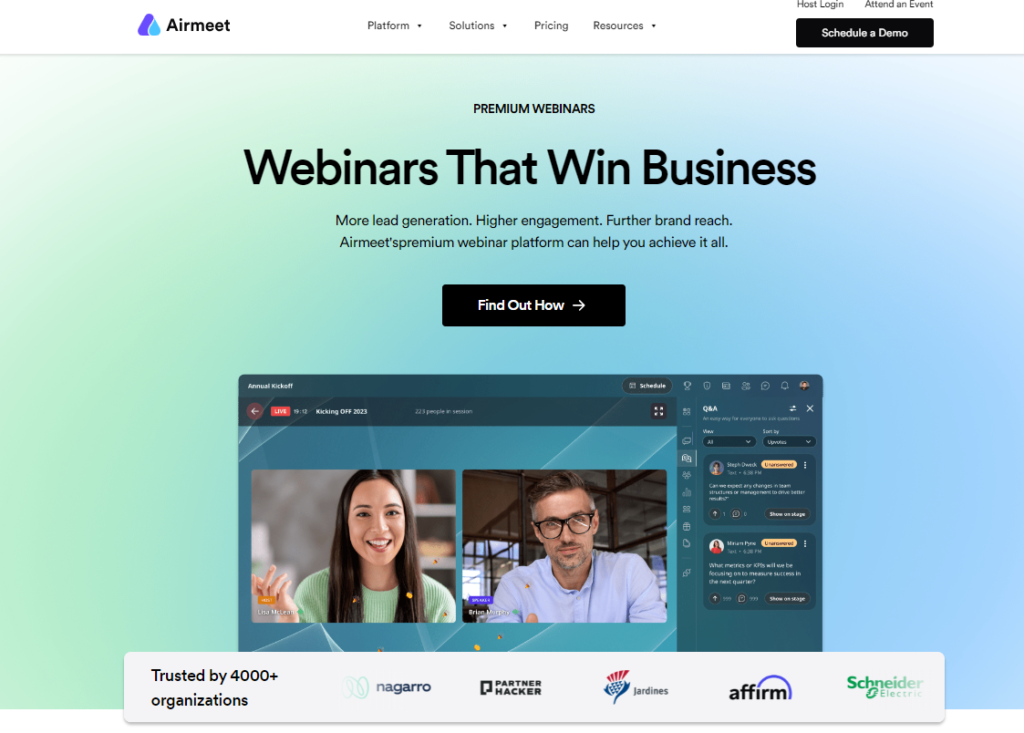
To ensure seamless coordination of your webinar events, Airmeet offers a wide array of features and functionalities, such as:
- Scalable and user-friendly platform with easily navigable icons and backstage support for your hosts, presenters, and speakers.
- Available as both web-based and mobile applications and compatible with various browsers and devices.
- 360-degree branding & customization features for every aspect of your webinar event, from webinar landing page to email templates.
- Robust engagement & networking capabilities, such as breakout sessions, polls, Q&A, raising hands, emoji reactions, speed networking, and networking lounges.
- Real-time analytics and detailed reporting capabilities provide valuable insights such as total registrations, attendee turnout, participant behavior & interest, engagement rate, and more.
- Seamless integration with a variety of powerful tools, including registration & ticketing solutions, CRM systems, marketing automations, survey tools, and gamification.
- Multi-lingual support to cater to your global audience, surpassing language barriers.
- In-built session recording feature and the ability to offer session replays post-webinar.
- 24/7 customer support and dedicated technical assistance to quickly address all your concerns in real-time.
Book your demo now or sign up for your free trial to see for yourself why Airmeet is trusted by thousands of enterprises as their preferred webinar platform.
FAQ
Common technical issues that could occur during the webinar include connectivity problems, audio and video disruptions, software glitches, and presentation upload failures.
You can utilize the live streaming options to share your live webinar with a wider audience.
Social media platforms, like LinkedIn and YouTube, are suitable for your webinar live streaming efforts.
Yes, coordinating multiple webinars simultaneously is possible, but it requires careful planning, adequate resource management, and reliable technology to manage both webinars smoothly without disrupting your audience experience.






